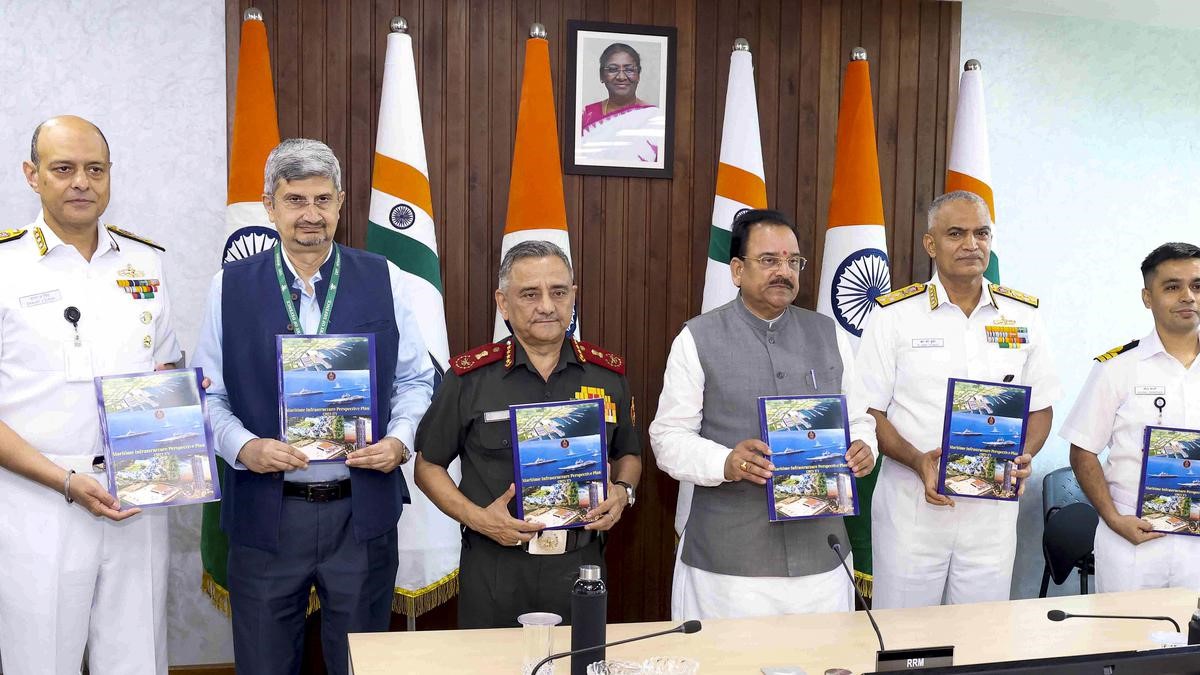Topics:
1. Maritime Infrastructure Perspective Plan (2023-37)
2. UPI-CBDC Interoperability: Advancing Retail Digital Rupee Adoption
3. ‘Atlantification’ of the Arctic Ocean
4. Plasma Analyser Package for Aditya (PAPA)
5. Self-Confining Radioactive-isotope Ion Target (SCRIT)
Maritime Infrastructure Perspective Plan (2023-37)
Context
- Key Message At the Naval Commanders Conference, the unveiling of the Maritime Infrastructure Perspective Plan (MIPP) 2023-37 marked the introduction of a forward-looking strategy aimed at promoting sustainable maritime infrastructure.
About MIPP
- In alignment with the overarching vision of the PM Gati Shakti project, the Minister of State for Defence introduced the comprehensive MIPP.
- This plan outlines objectives spanning the next 15 years, aiming to synergize the Navy’s infrastructure needs within a dynamic and all-encompassing framework.
Features of the MIPP
- Harmonizing Infrastructure Development: The MIPP 2023-37 envisions an integrated approach to address the Navy’s infrastructure requirements, meticulously designed to harmonize naval infrastructure development over the next 15 years.
- Compliance with Broader Policies: The plan adheres to broader policy directives, including the PM Gati Shakti Project, Disaster Resilience, and Transition to Net Zero, among others. Sustainability and alignment with national policy priorities are fundamental principles guiding the plan’s formulation.
- Modernization Initiatives: To accommodate technological advancements and promote self-reliance, the revised “IRS Rules and Regulations Handbook for Construction and Classification of Naval Combatants” was introduced, reflecting the growth of the naval shipbuilding industry and embracing the philosophy of ‘AatmaNirbharta’ (self-reliance).
- Transformational Projects: Milestones such as the release of the “Family Logbook for Defence Civilian Personnel of the Indian Navy” and the launch of the “Electronic Service Document Project” are poised to revolutionize HR record-keeping within the Navy, contributing to efficiency and modernization.
- Enhancing Indigenous Shipbuilding Promoting Homegrown Warships: Highlighting the Navy’s commitment to self-reliance, Ajay Bhatt noted that the last 33 warships were ‘Made in India.’ Currently, 61 out of 63 warships under construction are being built in Indian shipyards, showcasing the nation’s shipbuilding capabilities.
- Significant Launches: The President’s launch of Vindhyagiri and the Vice President’s launch of Mahendragiri underscored the strength of the indigenous warship-building enterprise.
Addressing Challenges and Preparedness Expanding Defense Horizons
- Recognizing that defense extends beyond traditional domains to include space, cyber, economic, and social dimensions, a holistic approach is essential.
- A ‘whole of a nation approach’ is crucial for effectively addressing evolving security challenges.
Vision and Preparedness:
- Chief of Naval Staff Admiral R Hari Kumar emphasized the Navy’s four-fold vision: executing missions successfully, upholding maritime security in the Indian Ocean Region, adapting to societal changes, and advancing jointness and integration with other services.
Conclusion
The Maritime Infrastructure Perspective Plan 2023-37 serves as a blueprint for India’s maritime progress, demonstrating a commitment to self-reliance, sustainability, and modernization.
With a focus on comprehensive development and adherence to national policies, the plan charts a course towards a stronger, more resilient naval infrastructure, aligned with the evolving security landscape and the broader objectives of the nation.
UPI-CBDC Interoperability: Advancing Retail Digital Rupee Adoption
Context
- The fusion of UPI (Unified Payments Interface) Quick Response (QR) codes with Central Bank Digital Currency (CBDC) applications is poised to usher in a revolution in digital transactions within India.
- This strategic amalgamation will empower users of the retail digital rupee, enabling them to conduct seamless transactions using UPI QR codes, thereby enhancing convenience for both consumers and businesses.
Understanding Interoperability
- Interoperability, in this context, signifies the technical compatibility that facilitates the harmonious functioning of diverse payment systems.
- It empowers various payment systems to collaborate across platforms, fostering efficiency, innovation, and user adoption.
Explaining UPI QR Code-CBDC Interoperability
- The Reserve Bank of India (RBI) is actively promoting interoperability between UPI and CBDC through an ongoing pilot project for the retail digital rupee (e₹-R).
- Initially, e₹-R users were required to use specific QR codes for transactions. However, with UPI-CBDC interoperability, any UPI QR code becomes compatible with CBDC applications.
- The digital rupee, issued by the RBI, is a tokenized digital representation of the rupee, securely stored in a digital wallet linked to a savings bank account.
- UPI, directly linked to a user’s account, can now seamlessly facilitate transactions with CBDC.
Benefits for Customers and Merchants
The convergence of UPI and CBDC brings forth numerous advantages:
- Customers can employ a single QR code for diverse transactions, eliminating the need for multiple platforms.
- Everyday essentials such as groceries and medicines can be procured using any UPI QR code.
- Merchants can accept CBDC payments without the necessity of creating separate QR codes.
- Transactions are streamlined and efficient, enhancing the overall user experience.
- Boosting CBDC Adoption The UPI-CBDC interoperability leverages the widespread use of UPI to bolster the adoption of the digital rupee.
- Over 70 mobile apps and 50 million merchants currently embrace UPI payments.
- The integration of UPI with CBDC simplifies transactions, augmenting the digital rupee’s utility.
- Leading banks like the State Bank of India, HDFC Bank, and Axis Bank have introduced UPI interoperability on their digital rupee platforms.
- This seamless integration is poised to reshape the digital currency landscape, driving its acceptance and utilization.
Conclusion
The achievement of UPI-CBDC interoperability represents a significant milestone in India’s digital payment ecosystem.
By combining the familiarity of UPI with the innovation of CBDC, the retail digital rupee becomes more accessible, user-friendly, and efficient.
This strategic integration is set to expedite the adoption of digital currencies, transforming the way transactions are conducted throughout the nation.
'Atlantification' of the Arctic Ocean
Context:
- In a recent publication in the journal Science, an international team of scientists has provided fresh insights into the process known as the “Atlantification” of the Arctic Ocean.
- This phenomenon offers an explanation for the stagnation observed in Arctic Ocean sea ice loss since 2007.
Noteworthy Findings from the Study:
- The Arctic Dipole:
The Arctic Dipole, also referred to as the Dipole Anomaly, is a relatively recent climatic pattern characterized by fluctuations in atmospheric pressure in the Arctic region. It has attracted increasing attention due to its significant impact on the extent of sea ice and its potential connection to weather patterns in mid-latitudes. The study delves into the multifaceted influence of the Arctic Dipole on the climate of the Arctic Ocean.
The researchers have identified that the Arctic Dipole follows a cycle of approximately 15 years, and they propose that we are approaching the conclusion of the current phase. The present “positive” phase of the Arctic Dipole, which has persisted since 2007, is characterized by high pressure centered over the Canadian sector of the Arctic, resulting in clockwise winds, and low pressure over the Siberian Arctic, leading to counterclockwise winds. This specific wind pattern has wide-ranging effects, impacting upper ocean currents, air temperatures, sea ice movement, heat exchange processes, and even ecological consequences.
- Switchgear Mechanism:
- The research also unveils a “switchgear mechanism” responsible for alternating changes in the Fram Strait and the Barents Sea. These alterations, triggered by the mechanisms of the Arctic Dipole, have significant implications.
- The influx of warmer Atlantic water into the Arctic is causing alterations in the ocean’s composition, driven by climate change.
- The Arctic Ocean is experiencing reductions in sea ice, weakening of the halocline (a layer of varying salinity), and a reduction in the depth of Atlantic warm waters.
- This is leading to an increasing influence of Atlantic water on the Arctic Ocean.
- The Major Layers of the Arctic Ocean:
The Arctic Ocean consists of several distinct water layers that remain separated due to variations in salt concentration, which affect water buoyancy.
- Top Layer: The uppermost layer consists of freshwater with low salinity, maintained at near-freezing temperatures. This freshwater originates from the melting of sea ice and the discharge of Arctic rivers into the ocean.
- Saline Layer: Below the top layer lies a saltier and warmer water layer from the Atlantic.
- Arctic Halocline: An intermediate layer called the Arctic halocline separates these two layers. Here, warm, salty water mixes with the cold, fresh surface layer above.
- Arctic Deep Water: Beyond the warm and salty Atlantic layer, another water mass of cold and slightly saltier water, known as Arctic deep water, exists.
Maintaining the Layered Structure:
- The key factor responsible for preserving the layered structure of the Arctic Ocean is thermohaline circulation, often referred to as the “Great Ocean Conveyor Belt.”
- This circulation system involves the movement of ocean water based on differences in temperature (thermo) and salinity (haline).
In the Arctic Ocean, cold and dense water sinks beneath warmer and less dense water, resulting in a layered structure that keeps the various water layers distinct.
PLASMA ANALYSER PACKAGE FOR ADITYA (PAPA)
What is the Plasma Analyser Package for Aditya?
- The Plasma Analyser Package for Aditya (PAPA) represents a vital component of the Aditya-L1 mission.
- Its primary purpose is to gather essential data regarding the solar wind plasma, encompassing parameters like density, temperature, and composition.
- Furthermore, it aims to explore the dynamics between the solar wind and the Earth’s magnetosphere.
PAPA comprises two distinct sensors:
- Solar Wind Electron Energy Probe (SWEEP): This sensor is responsible for quantifying the electron fluxes within the solar wind.
- Solar Wind Ion Composition Analyser (SWICAR): SWICAR’s role is to analyze and measure the ion fluxes found in the solar wind.
Additionally, the Aditya-L1 mission encompasses several other essential payloads, including:
- Visible Emission Line Coronagraph (VELC)
- Solar Ultra-violet Imaging Telescope
- Solar Low Energy X-ray Spectrometer (SoLEXS)
High Energy L1 Orbiting X-ray Spectrometer (HEL1OS)
Self-Confining Radioactive-isotope Ion Target (SCRIT)
Context
- In a breakthrough achievement, researchers at the RIKEN Nishina Center for Accelerator-Based Science in Japan have successfully unveiled a pioneering setup capable of utilizing electron scattering to gain insights into the inner workings of unstable nuclei, employing the innovative SCRIT technique.
- Electron scattering experiments represent a valuable approach to investigating the structural composition of matter.
- For instance, consider the classic Rutherford model experiment, where scientists like Ernest Rutherford, Ernest Marsden, and Hans Geiger deduced the presence of a concentrated mass and positive charge at the core of every atom by observing the deflection of rays as they passed through a gold foil.
About the Self-Confining Radioactive-isotope Ion Target (SCRIT):
Objective:
- The primary goal of SCRIT is to delve into the internal structures of ephemeral exotic nuclei through electron scattering.
- It harnesses an inventive ion-trapping method to prepare a target composed of exotic nuclei for electron scattering within the confines of an energetic electron beam.
- The utilization of an electron storage ring to confine radioactive isotopes is a key feature, enabling the performance of electron scattering experiments on unstable nuclei, a feat unattainable with conventional fixed targets.
Advantages:
- The SCRIT technique boasts numerous advantages when compared to conventional fixed target setups.
- It facilitates experimentation with unstable nuclei characterized by exceedingly short half-lives, which would naturally decay before they could be employed in a fixed target experiment.
- Additionally, SCRIT offers significantly enhanced luminosity, permitting the collection of a larger volume of data in a shorter duration.
- Moreover, its operational costs are relatively low, rendering it a cost-effective alternative for conducting electron scattering experiments.
Applications:
This pioneering technique is poised to find application in a diverse array of future experiments, including investigations into nuclear structure, the dynamics of nuclear reactions, and the astrophysical genesis of elements.




